Have you witnessed a dip in organic traffic to your site? It’s possible that you are being penalized for violating Google Webmaster Guidelines.
It’s important to keep in mind, Google doesn’t care whether you hired a sketchy SEO firm or tried to game Google yourself -– if your site is hit with a penalty, you’re the one that must deal with it.
Now, truth be told, there are many reasons why a decrease in organic search traffic can occur. Before you go straight to penalization first consider these common causes of traffic loss…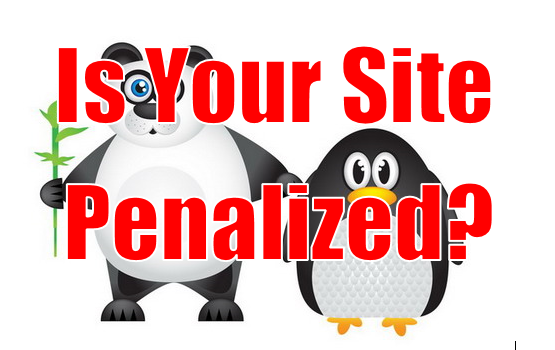
Common Causes of Traffic Loss
Recent Redesign – Did you recently redesign your website or move platforms? This could have caused a drop in rankings and traffic.
Competition is doing better – If your site has been stagnant for quite some time, while your competition has been growing with new content, focus on social media, maybe a new site design, etc., they may have taken control of the SERPs.
Inaccurate Analytics – Check your tracking code from Google Analytics and make sure there isn’t an issue here.
Different Source or Medium – Make sure you are dealing with Google organic traffic and not Bing, or Referral traffic.
Big Site Changes – Have there been any recent changes to the site that might affect visitor performance, content, or links? Go back and see what changes were made to the site at the time of the traffic drop to see if that could be the cause.
Seasonality – Make sure you’re checking year-over-year traffic in Analytics.
Backlinks Were Removed – If you had backlinks helping you out in the search engines that have been removed, or possibly even moved, this could absolutely result in traffic and rankings decrease.
Have I Been Penalized?
If you went through some of the common causes of traffic loss and have determined that those are not the issue, then it’s time to dive into your Google Analytics account. You’ll want to check your organic Google traffic for significant drops in traffic over a very short period of time – usually you’ll see a huge drop (well over 50% in most cases) within a few days or less.
Penalties often look something like this…

Panda Penalty Analytics – source seo4anyone.com
Does my site have a Manual Penalty?
A manual penalty is when an actual human being from Google noticed that you were doing things they didn’t like and so they decided to slap your domain with a penalty. Here are the different types of manual actions Google might take.
Manual penalties happen all the time. In fact, Matt Cutts (Head of Webspam at Google) says in the video below that in January of 2013, 431,000 messages were sent as a result of actions that the webspam team took on sites violating their guidelines.
The good news is that this is very easy to diagnose with the launch of Google’s Manual Penalty Checker. There’s also a good possibility you would have received a message from Google in Webmaster Tools.
Here is a screenshot of the Manual Action section in Google Webmaster Tools
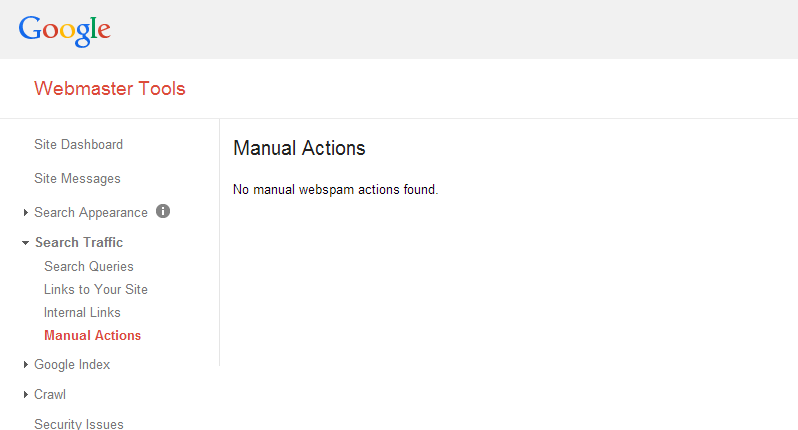
Manual Action Penalty Checker
Here’s what a message from Google looks like
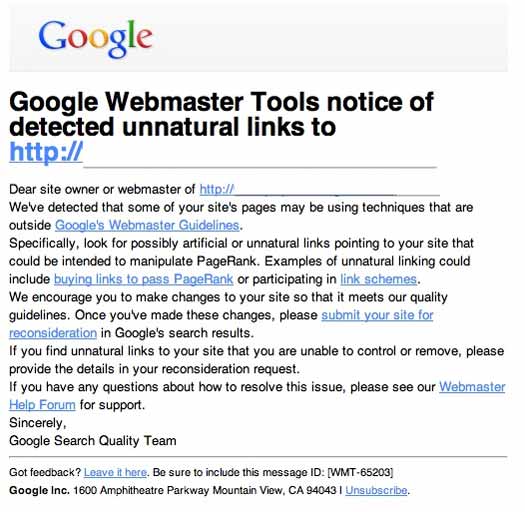
Google Penalty Message (source: searchenginejournal.com)
Now, the bad news is, if you have a manual penalty, you’re going to have a hell of a time getting rid of it and bringing your rankings back up to where they once were.
Here’s what it might look like if you’re about to have a bad day…
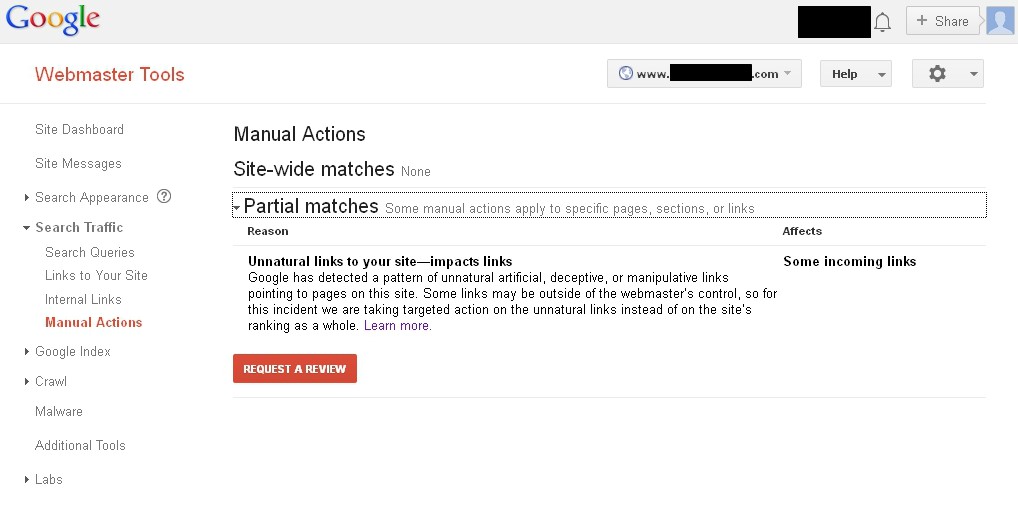
Partial Match Manual Action
Does my site have an Algorithmic Penalty?
Algorithmic penalties like Penguin or Panda are (sometimes) a bit harder to detect. First let’s talk about what they are.
Panda
Panda is an update Google made to their algorithm in early 2011. Google’s primary goal here was to decrease sites that had poor content – but when I say poor content, I’m referring to lots and lots of very bad content.
Penguin
Penguin is an update from April of 2012 which mostly targets the over-optimization of links pointing in to a website. So, if you were selling car accessories and had hundreds of links pointing to your site that said “car accessories”, chances are you were hit with some form of Penguin.
Ok, so how can we diagnose an algorithmic penalty?
First, go into your Google Analytics account and determine when your traffic fell. Make sure you segment only your organic traffic from Google. Look for a steep drop in traffic in a very short period of time.
Once you’ve established when the traffic drop occurred, head on over to the Moz Google Algorithm Change History to see if the date of the traffic drop coincides with either a Panda or Penguin update.
How can I Recover my Traffic?
The sad truth is that recovering to 100% of your organic traffic before your site was penalized probably will not happen. On the other hand, site penalties are not going to just go away with time. So if you discover that you were hit by either an algorithmic or manual penalty, you must take action.
Recovering from a Manual Penalty
This is actually the most difficult to recover from, because an algorithmic penalty is usually also involved, so it’s sort of a double whammy. The only good thing about a manual penalty is that you know when it goes away because it will no longer be listed in the Manual Actions section of Google Webmaster Tools.
To recover from a manual penalty, you must remedy the violations of Google’s quality guidelines, and send in a Reconsideration Request to Google.
Side note: I thought it was noteworthy to point out something else from the Matt Cutts video (above) about the Reconsideration Requests. Matt mentioned there were 431,000 messages sent to websites regarding manual actions being taken, but only about 20,000 Reconsideration Requests were submitted in the same timeframe. This means less than 5% of that 431,000 are attempting to reconcile. So, what does that mean for you? Not really a lot. I just thought it was interesting.
Anyway, regarding Reconsideration Requests, I’ve seen what works and what doesn’t, and it’s very important to be extremely detailed in your Reconsideration Request. Here are some tips that will help with your R.R.
Document Everything – Create a spreadsheet and document all of the bad links that point to your site (if that’s the issue). Add dates, add notes about what you did to try and remove the links, add how you followed up later on, and anything else you can think of that demonstrates you put a lot of effort into this.
Go Overboard with Link Removals – People are very scared to remove links that they think might still be helping their rankings. If there is any question at all whether or not a link is “bad”, go ahead and try and remove it.
Be Transparent – Tell Google what you did, tell them who was involved, if it was some overseas SEO firm or whoever, tell them what measures you’ve taken to ensure that your company is through with these seedy practices.
Here’s a Q&A Danny Sullivan did with Matt Cutts about what to do if you get a manual penalty.
Recovering from an Algorithmic Penalty
To recover from something like Panda or Penguin, you must be willing to make major changes.
For Panda, you need to discover what pages of your site are of such low-quality that got you penalized in the first place. Maybe a large percentage of your website has thin or duplicate content. Could be you have hundreds of articles copied from other sites. Bottom line is, there is clearly a quality issue with your webpages.
For Penguin, you need to discover what links are pointing to your site that are unnatural and remove them. For those that you cannot remove, disavow them in Google’s Disavow Tool – but only do this for links that you CANNOT get removed.
Also, remember that submitting a Reconsideration Request for an algorithmic penalty will not do any good, so don’t waste your time.
Comments Welcome!
Hey guys, if you have any questions about site penalties, comment below!
If your site has been penalized by Google, it’s essential that you seek the aid of an expert. Penalties placed on websites are known to get worse before they get better.
Clint Henderson
Latest posts by Clint Henderson (see all)
- How to Score Content Quality for Improved SEO Rankings (CQ Scoring) - September 8, 2017
- 2017 Mobile Marketing Statistics (Trends, Predictions, & Mobile Strategy) - April 1, 2017
- Ecommerce SEO for Product Pages (17-Step Guide) - January 27, 2017
Related Articles
 May 23, 2014 Google Panda Recovery (Panda 4.0) – Case Study
May 23, 2014 Google Panda Recovery (Panda 4.0) – Case Study August 8, 2013 Google Launches Manual Penalty Checker in Webmaster Tools
August 8, 2013 Google Launches Manual Penalty Checker in Webmaster Tools September 14, 2016 Increase Organic Click-Through Rates (CTR) by 30%+
September 14, 2016 Increase Organic Click-Through Rates (CTR) by 30%+ February 6, 2015 Google Algorithm Update: Is Google Punishing Sites with Poor Mobile User Experience?
February 6, 2015 Google Algorithm Update: Is Google Punishing Sites with Poor Mobile User Experience? August 24, 2013 Google Plus: The Best Social Network for SEO
August 24, 2013 Google Plus: The Best Social Network for SEO
SEO Services
Wired SEO Company
Fort Worth Office

Wired SEO Company
Address:
Fort Worth, TX 76117
Website: www.wiredseo.com

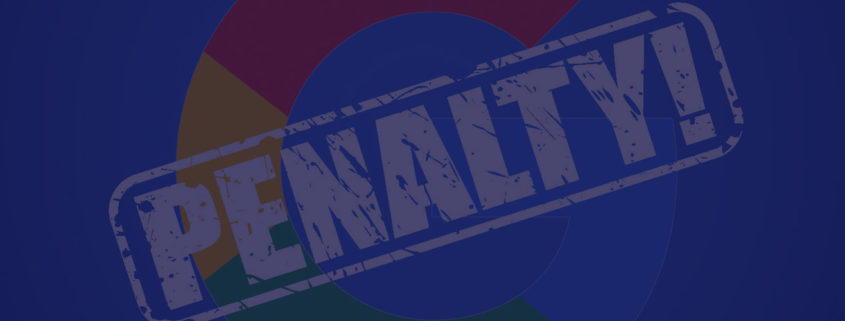












Leave a Reply
Want to join the discussion?Feel free to contribute!